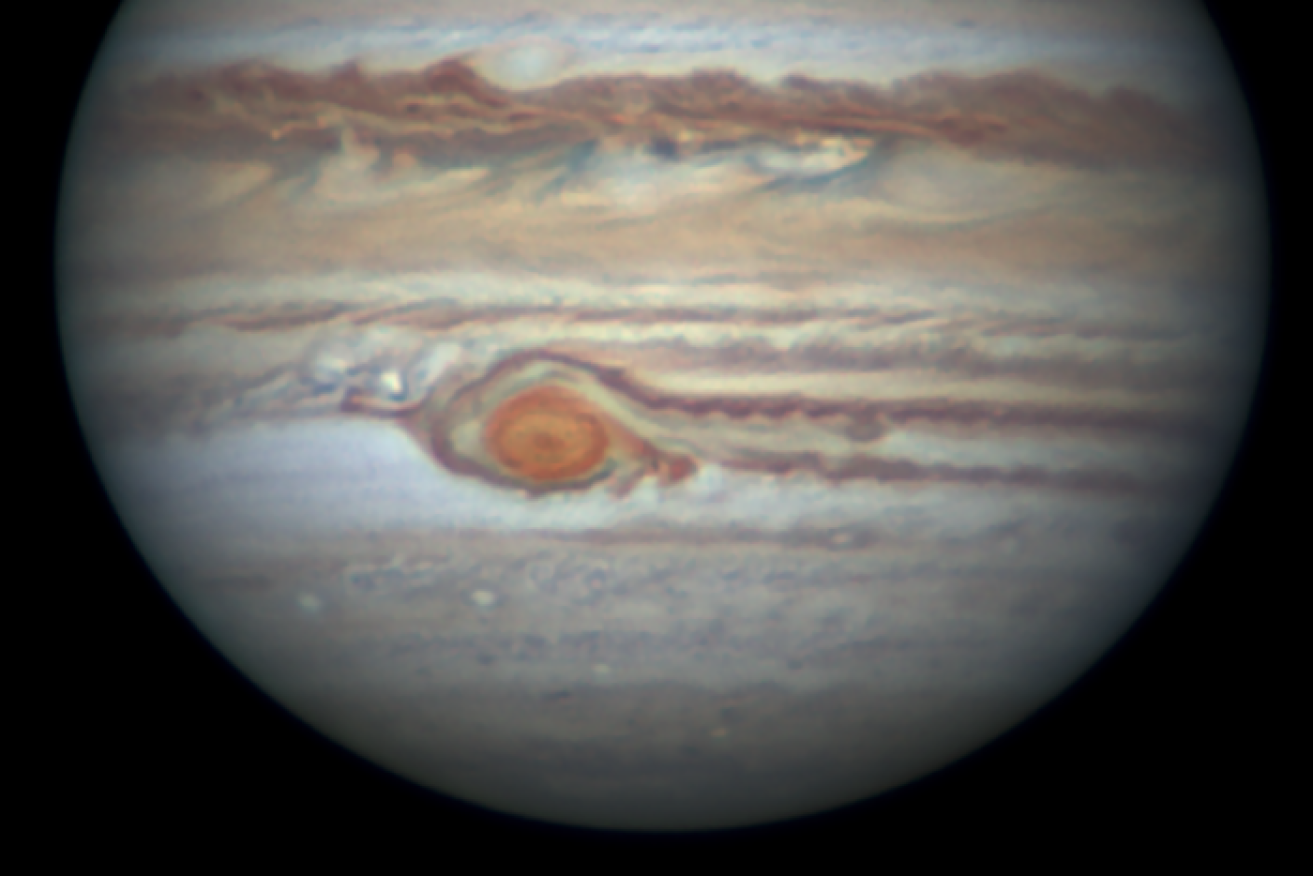Australian backyard astronomer praised for epic photos of Jupiter’s Great Red Spot

For about seven weeks, parts of Jupiter's Great Red Spot cyclone have been breaking off, under threat from other storms. Photo: Anthony Wesley
Experts have praised an amateur astronomer from central Queensland for documenting a historic planetary event through a homemade telescope.
A storm has been raging above Jupiter for more than 200 years, known as its Great Red Spot.
But the storm may be in its death throes, under attack from other weather events which have been circling the gas giant since April.
The cosmic event has gained the attention of professional and amateur astronomers around the world, but one Australian computer programmer has stunned experts with his images.

Anthony Wesley built his telescope using mirrors, a metal frame and a camera. Photo: jupiter.samba.org
Trading city lights for starry Queensland sky
In 2017, Anthony Wesley and his wife Leisa moved from Canberra to a remote central Queensland town for its weather, and because it was conducive to stargazing.
He worked as a government computer programmer before the tree-change took him to the remote property at Rubyvale — a four-hour drive west of Rockhampton.
He works for a photo company from home but can also be found at the observatory in his backyard, looking closely at his favourite planet.
“I’m a Jupiter enthusiast,” Mr Wesley said.
Only 640 people live in Rubyvale, but Mr Wesley said he knew of at least six other space enthusiasts in the area.
He said the weather conditions were just right for stargazing.
He is out every morning and night looking at the planet and its most striking feature – the Great Red Spot – but in April, something changed.
“It’s been quite dramatic … [the images have been] showing the spot in a state that nobody’s ever seen before,” Mr Wesley said.
“It’s suddenly, in the last two months or so, started to undergo these massive peeling, or flaking events.
“Large, enormous pieces of storm are being shredded off by other storms nearby and Jupiter’s red spot is shrinking – shrinking much more rapidly than it has been.
“No one has really seen this happen before and no one can really predict what is going to happen.
Mr Wesley said all his images were taken on his telescope, which he made at home from mirrors and metal framing.
It is attached to a camera lens mounted on what he calls a “system that tracks the sky”.
Amateur’s ‘incredible images’
Jonti Horner, who is a professor of Astrophysics at the University of Southern Queensland, said Mr Wesley’s latest photos were some of the best he had seen.

A photo of Jupiter’s Great Red Spot taken by Anthony Wesley in April, before it began to unravel. Photo: Anthony Wesley
“While he’s an amateur photographer in that it’s not his day job, he’s essentially a professional — he does such an incredible job of his imaging,” he said.
“He’s got a long and storied history of getting incredible images of Jupiter and has been on a significant number of scientific papers.”
Professor Horner said Mr Wesley was among a group of international space enthusiasts who had been documenting the changes during recent weeks.
Editor of Australia’s Astro Space News David Reneke said discoveries like these could not be made without amateurs like Mr Wesley, who looked at the same thing night after night.
“Because we use the term amateur, people think they’re second rate, third rate – well they’re not,” Mr Reneke said.
“What Anthony has been doing here is produce photos that I’ve not seen even with the giant telescopes.

An image of Jupiter’s Great Red Spot taken by NASA’s Juno spacecraft in 2017. Photo: NASA/JPL-Caltech/SwRI/MSSS/Roman Tkachenko
“Where he and other amateur astronomers come in here, they fit the gap that astronomers can’t do.
“Where the amateurs come in they have time on their hands — this is their hobby and they’ve got some excellent equipment now.
“Some of the telescopes you can buy now over the counter rival any telescope 20 or 30 years ago right around the world.”
Discovery helps experts understand the planet
There is disagreement among the scientific community about how old the Great Red Spot is.
Some argue it was discovered in the 1600s, but Professor Horner said it was unclear whether that was the same storm that is visible in 2019.
“The debate over whether it is 400 or 200 years old is a really interesting one because a red storm was seen by Giovanni Cassini back in the 1650s, and it has been regularly observed since the 1800s, but there were no observations during the 1700s,” Professor Horner said.
“That doesn’t mean it definitely wasn’t there.”
He said the planet may be susceptible to sustained extreme weather events.
“Either the storm is 400 years old, probably longer, or that storms like the Great Red Spot are a common feature of its weather,” said Professor Horner.
He said the outcome of this event would lead to greater understanding of the planet, the biggest in our solar system.
“In a way what we will see over the coming years, the coming decades will actually help us to work that out as we work the atmosphere and how it behaves.”
–ABC








